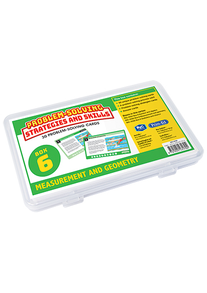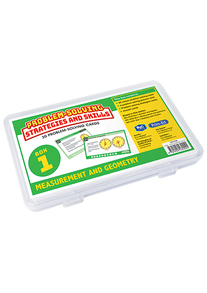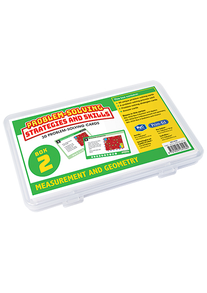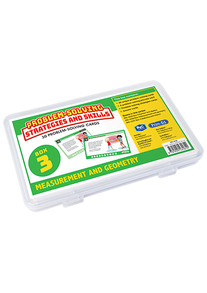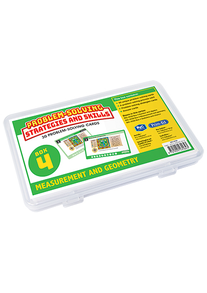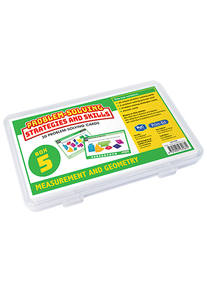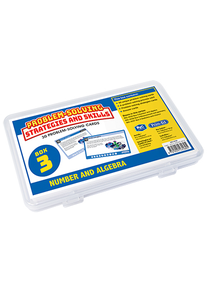-
0
Your cart is currently empty.
-
0
Your cart is currently empty.
-
Problem-solving Strategies and Skills: Measurement and Geometry Box 6
Preview Book
- Format: Boxed Resources
- Series: Problem-solving Strategies and Skills Maths Cards
- Code: 6165 | ISBN: 9781925431704
- Subject: Mathematics
- Level: 6th Class
Price:
19.95
Quantity:
Embed Mathematical Problem-Solving and Reasoning with the Problem-Solving Strategies and Skills Maths Cards.
These cards provide a wide variety of motivating and high-interest problem-solving activities. The front of each card has a mathematics word problem for pupils to solve and the reverse of each card has an extension activity for more able pupils. The problems involve one or several steps, require the use of a variety of strategies and skills and are supported by colourful artwork.
The core concepts in the Problem-solving Strategies and Skills: Measurement and Geometry Box 6:
- length
- area and perimeter
- weight/mass
- volume/capacity
- 2-D shapes
- 3-D shapes
- location and transformation
- angles
- tessellations
-
I was very eager to try these and hoped they would give me a bit more structure and focus regarding problem solving. It is an area of the Maths curriculum that I find needs more attention than I have previously given it. This year I decided to dedicate one day per week to Problem solving. This means that I can link it in to all other topic areas I am focusing on, hopefully this will help the boys increase in confidence when it comes to problem solving. There are three boxes for each class level, 1st to 6th Class,comprising: 30 Number and Algebra cards, plus answers 30 Measurement and Geometry cards, plus answers 30 Statistics and Chance cards, plus answers The front of each card has a word problem and the reverse of each card has an extension activity. This makes it a perfect activity for those higher achievers and early finishers. I have tried out several different levels and am very impressed. The cards are colourful and fun, this is very different to how the problem solving questions in a lot of textbooks are presented. I find that in our school text books there is one full page of questions at the end of a topic that the children always complain about having to do. The level of vocabulary is quite high and I found that I started using the level below with my students, e.g. the third class students use Box2. This is to help them become more familiar with the vocabulary, also to develop confidence and a sense of achieving. The challenge of the cards themselves is enough at the minute. I hope to move them on to Box 3 after Christmas when they are more confident in their ability. The cards are a great resource for group work and I am hoping to use them in Maths hour. The boys are actually excited to use the cards, they look forward to the challenge every Thursday. We mix up working as a group, in pairs and individually. It is great to see how the cards encourage them to work together and they bring out their competitive streak. When we finish a card we put it in the pile that is wrapped in an elastic band. This means we can keep track of what we have done and it is easy to see what we have left to do. Having used these Problem Solving cards for the past month I would definitely recommend them, Although the cards would be suited to both classroom or a SEN setting I like having them in SEN. Sometimes it is hard to find resources like this that are specific to when a child comes for learning support. They often see it as a fun activity and a change from their regular textbook. As I have said before I love my the Prim-Ed Maths Boxes and I feel that these Problem solving cards will be a great addition to my class. I would say that it is worth really thinking about what level would suit your class, if they really struggle with problem solving or reading then it might be worth going for an easier level.
Mentoring Muinteoir -
Have you ever worked on problem-solving in the class and when you ask a child how did they get that answer they reply ‘I just did!!’. I try and encourage more discussion in my class for problem-solving so they can recognise language and strategies to use too. I have been using the Problem-Solving Strategies and Skills Cards from Prim-Ed with my Senior Classes over the last few weeks and we all have really enjoyed them. There are 3 boxes in the series, Number and Algebra, Measurement and Geometry and Statistics and Chance. Each box contains 30 problem-solving cards, a process card, strategy cards and much needed answer cards. They are available from 1st class right up to 6th Class. In my own class I let 5th and 6th work together and give each pair a card to solve, on one side there is a problem to solve but there is also extension activities on the other side for those who might solve the problems quicker. We started with 5th class cards initially, again the language was challenging but I explained that language like that on the cards would be used a lot more next year for 6th class. The children worked together to solve the problem, then we reported back to the class. We put the card under the visualiser for everyone to see and then used some ‘thinking time’ before the pair explained how they solved it. I also allowed some feedback and other solutions from the class before moving on to the next card. I use ‘thinking time’ a lot in the classroom, I found the same children were putting their hand up and shouting out answers and for others they became reluctant to even try as they felt they wouldn’t be fast enough. through using thinking time it allowed all students time to think without shouting out or knowing others were already waving their hands at me. The more thinking time they got, the more hands went up at the end. Overall I really liked using these cards, I intend to incorporate them into my daily routine next year. I particularly like the chance cards as this topic is often towards the end of the book, but through using the cards throughout the year the children will become more familiar with the language of chance before meeting the topic later in the year. These cards encourage children to approach problem-solving in a variety of ways. Children also recognise specific language easier when they see it repeated in different cards. I think these cards are well worth the investment for your classroom and I look forward to using them more.
Aistear Múinteoir

